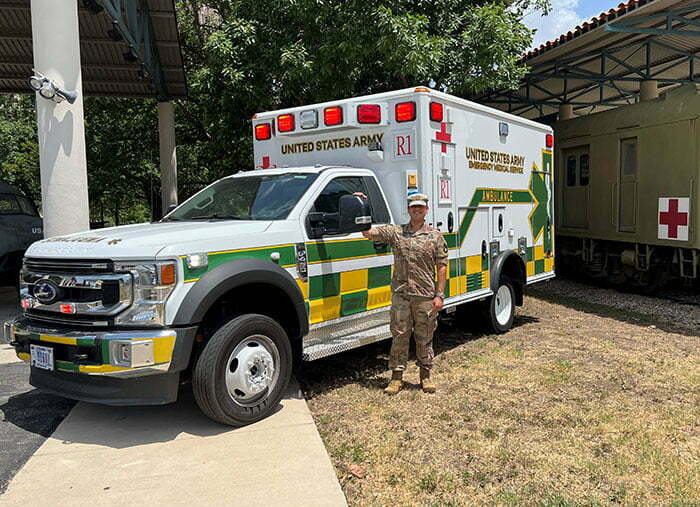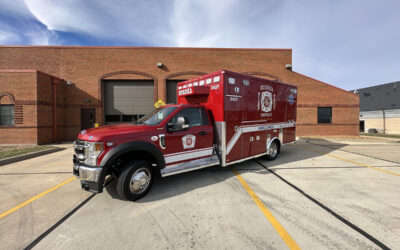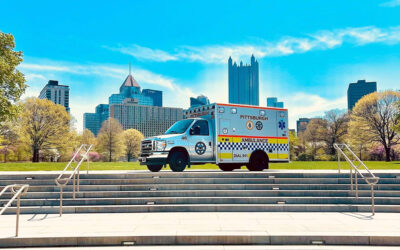
Maj. Nicholas Studer poses with the updated version of the Army metropolitan ambulance, which he helped redesign. The use of the Red Cross emblem on the vehicle – the first time since 1979 that Army EMS vehicles have used the symbol – is intended to connect the current fleet of vehicles with the proud history of American military ambulances. (Photo credit: ISR Public Affairs)
Ramin A. Khalili, USAMRDC Public Affairs Office
When Maj. Nicholas Studer got the call from his boss back in 2021, he couldn’t believe his luck. An Emergency Medical Services physician and combat casualty care researcher at the U.S. Army Medical Research and Development Command’s Institute of Surgical Research, Studer had just been tasked with designing the Army’s new metropolitan ambulance, the first official redesign of the vehicle since the late 1970s. For a self-admitted “car guy,” it was a dream come true.
“Mr. Dean Ross and Dr. Andrew Cap came to me and said, ‘Major, you like ambulances, why don’t you try working on this?'” says Studer, referencing the colleagues who helped direct the project his way in the first place. In a stroke of serendipity, Studer collects antique ambulances as a hobby. “So, I said sure – we’ll do this as an ISR project, it won’t take too much effort at all.”
The roots of the redesign stretch back to 2019, when the then-Secretary of the Army directed the Office of the Surgeon General to standardize the Army Emergency Medical Service as a means to provide a safety net against preventable deaths on military installations. Studer was named the first-ever medical director of the Army EMS, with his first order of business being to tackle the fleet of ambulances – a group that was considered too clunky and ill-equipped for the modern military.
“We rebuilt these new ambulances from the bottom-up, using best practices from the military and civilian sectors,” says Studer, who notes the new models factor in almost every advance in tactical combat casualty care developed in the past 40 years. Among a litany of other updates, the vehicles include blanket warmers to prevent hypothermia in trauma casualties as well as the capacity to support the delivery of chilled whole blood. “We’ve made the truck shorter and lighter so it’s able to go off-road in the types of austere conditions the Army uses for training. It’s better in almost every way.”
The chief advantage of the new metropolitan ambulance is that it cuts down on redundancy, which improves response time. Previously, the Army would use a standard field ambulance to respond to injures in training areas. The injured Service Member would then be driven to a waiting metropolitan ambulance, which would then proceed via surface streets to a medical facility. In response, the new models are designed to be light and durable enough to handle both off-road efforts as well as city driving. In a decidedly high-tech twist, the new version also comes equipped with a remote-activated fogger system that sprays the interior with a mist that kills select viruses – a feature that would be particularly useful in a setting such as the recent COVID-19 pandemic. The ambulance also houses an ultraviolet light that disinfects all equipment and exposed surfaces. More practical updates include standard four-wheel drive and the capacity to carry three casualties as opposed to just one.
“We have really been blessed with these things,” says Marc Rogers, chief of EMS at Fort Campbell, Kentucky, who received a new metropolitan ambulance five months ago. “With the high-octane, up-tempo training events that happen on this installation, having the capability to transport multiple patients in one unit is a game changer.”
After a relatively quick 18-month development process – one that included more than ten separate revisions – 28 brand new Army metropolitan ambulances will be delivered to military installations across the country this year, with the ultimate goal being to place at least one on every Army post. A total of 15 vehicles are already in use at locations including Fort Meade, Maryland; the U.S. Military Academy at West Point, New York and the aforementioned Fort Campbell. Over the next five years, the Army will procure at least 120 such vehicles. The ambulance is so popular with emergency personnel that, according to Studer, it was adopted as the standard, non-tactical ambulance of both the U.S. Air Force and the Defense Logistics Agency.
For Studer, the effort has allowed him to combine all the things he truly enjoys: the Army, medicine, patient care and cars (as for the latter, it bears mentioning that he is a member of the Board of Directors for The Professional Car Society). Even more, he gets to use those talents for the benefit of MRDC, allowing the command to make yet another lasting mark on military medicine.
“It’s definitely a major accomplishment for the Army,” says Studer. “The old ambulance was just an ambulance – this one is going to help change how the system works. The new ambulance is the symbol of that change.”




